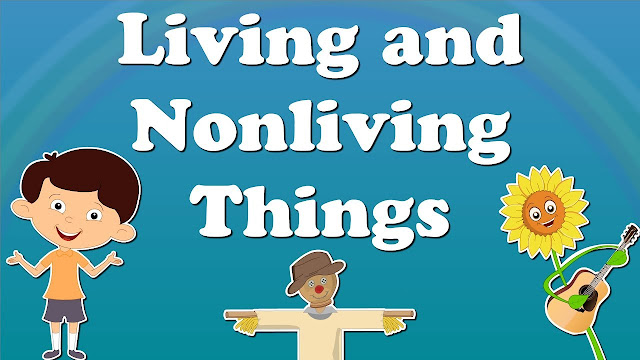Living and Nonliving Things Examination Test Questions and Answers
Living and Nonliving Things Examination Test Questions and Answers.
We are surrounded by living and non-living things. All animals and plants are living things and biology is the study of these living things. A cat playing with a ball is obviously living. A pigeon flying from tree to tree is also a living thing.
Living things, as the name suggests, are lively and active. They are made up of cells; exhibit characteristics of life, like growth, movement, reproduction, response to stimuli; they evolve, and require energy for daily activities. Some of the daily life examples of living things around us are human beings, animals, plants and micro organisms.
Non-livings things do not exhibit any characteristics of life. They do not grow, respire, need energy, move, reproduce, evolve, or maintain homeostasis. These things are made up of non-living materials. Some examples of non-living things are stones, paper, electronic goods, books, buildings, and automobiles.
Examples of Nonliving Things.
Sand, wood and glass are all non-living things. None of them shows any of the characteristics listed above. Non-living things can be divided into two groups. First, come those which were never part of a living thing, such as stone and gold.
The second group are those which were once part of living things. Coal is a good example. It was formed when trees died and sank into the soft ground. This happened many millions of years ago when the Earth was covered with forests. Paper is non-living but it is also made from trees. Jam is also non-living but it was made from the fruit of a plant.
Characteristics of Living Things.
1. Feeding – All living organisms need to take substances from their environment to obtain energy, to grow and to stay healthy.
2. Movement – All living organisms show movement of one kind or another. All living organisms have internal movement, which means that they have the ability of moving substances from one part of their body to another. Some living organisms show external movement as well – they can move from place to place by walking, flying or swimming.
3. Breathing or Respiration – All living things exchange gases with their environment. Animals take in oxygen and breathe out carbon dioxide.
4. Excretion – Excretion is the removal of waste from the body. If this waste was allowed to remain in the body it could be poisonous. Humans produce a liquid waste called urine. We also excrete waste when we breathe out. All living things need to remove waste from their bodies.
5. Growth – When living things feed they gain energy. Some of this energy is used in growth. Living things become larger and more complicated as they grow.
6. Sensitivity – Living things react to changes around them. We react to touch, light, heat, cold and sound, as do other living things.
7. Reproduction – All living things produce young. Humans make babies, cats produce kittens and pigeons lay eggs. Plants also reproduce. Many make seeds which can germinate and grow into new plants.
Key Point to Note About Living and Non-ling Things.
1. There are seven characteristics of living things: movement, breathing or respiration, excretion, growth, sensitivity and reproduction.
2. Some non-living things may show one or two of these characteristics but living things show all seven
3. Non-living things can be divided into two groups, those which were once part of a living thing and those which were never part of a living thing.
Living and Non-living Things Work Sheet.
This will guide you on various types of questions on living things, non-living things, natural things and man-made things. Especially, how and what to expect on your examination.
1 – THEORY (Answer the following questions)
1. What are living things?
2. What are non-living things?
3. What are natural things?
4. What are man-made things?
5. Give two examples of living things.
6. Give two examples of non-living things.
7. Give two examples of natural things.
8. Give two examples of man-made things.
9. What are the five differences between living things and non-living things?
10. Write six features of living things.
2 – SUBJECTIVES (Fill in the blanks with the correct words):
1. All plants and _________ are living things. (animals/wood)
2. Most plants grow from _________. (seeds/eggs)
3. Non-living things found in nature are called _________ things. (man-made/natural)
4. Non-living things made by man are called _________ things. (man-made/natural)
5. Animals lay _________ or give birth to young ones. (seeds/eggs).
Answers to Questions.
1. THEORY.
1. Living things breathe, move on their own, need food, feel, grow and reproduce.
2. Non-living things cannot breathe, move on their own, eat food, feel, grow and reproduce.
3. Non-living things found in nature are called natural things.
4. Non-living things made by man are called man-made things.
5. The two examples of living things are plant and cat.
6. The two examples of non-living things are chair and pencil.
7. The two examples of natural things are stone and water.
8. The two examples of man-made things are train and houses.
9. Click here to know about the five differences between living things and non-living things.
2. SUBJECTIVES.
1. animals
2. seeds
3. natural
4. man-made
5. eggs.
Summary:
1. Living things can move, but non-living things cannot.
2. Energy is required by living things, while non-livings do not require energy.
3. Living things are capable of growth, reproduction and death.
4. Non-living things are non-motile, but living things can move around.
5. Living things respire; non-living things do not respire.
6. Living things adapt to the surroundings and respond to stimulus.
What’s your take on this? We believe this article was helpful, if yes, don’t hesitate to share this information with your friends on Facebook, Twitter, Whatsapp and Google plus.
CSN Team

